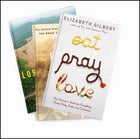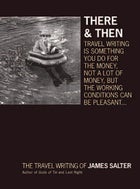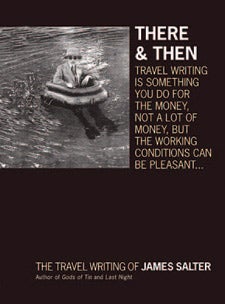Eat, Pray, Love
From Our Pages
“For a long time, whatever the opportunity, if it meant travel, I took it,” writes James Salter in There and Then (Shoemaker & Hoard, ), a collection of 18 spare, elegant essays the novelist (Solo Faces, Last Night) published between 1985 and 2003. Salter climbs in Chamonix, cycles through Japan, and skis in Austria, Switzerland, and Aspen. “There are days, months, even years when you feel invincible, dropping down the face of Bell, Corkscrew, Lower Stein as if slipping down the stairs, edges biting, bumps disappearing in your knees,” he writes in his classic essay “The Skiing Life,” which appeared in şÚÁĎłÔąĎÍř in December 1992. “The memory of it all will stay forever.” —Dianna Delling

One Woman’s Search for Everything Across Italy, India, and Indonesia
Elizabeth Gilbert
(Viking, $25)
IN HER EARLY THIRTIES, Elizabeth Gilbert had everything: a successful writing career, a big house in the suburbs, and a husband itching to start a family. Before long, she freaked. “Until I can feel as ecstatic about having a baby as I felt about going to New Zealand to search for giant squid,” she reasoned, she just couldn’t take the plunge. So Gilbert, author of the National Book Award–nominated The Last American Man (2002), divorced her husband and set out to explore her budding spirituality—a mix of kundalini yoga, meditation, and chats with God—on a yearlong solo trip she candidly documents in Eat, Pray, Love. Part travelogue, part spiritual memoir, the book is as much about food and relationships as about the meaning of the universe. “I am ashamed to admit this, but I did not visit a single museum during my entire four months in Italy,” she writes in her charming, as-told-to-her-best-friend voice. “I found that all I really wanted was to eat beautiful food and speak as much beautiful Italian as possible.” Gilbert is by turns self-revelatory and self-indulgent but never didactic, a likable tour guide to her own mind—and to the mindful tenets behind the yoga poses.
—Florence Williams
The Worst Hard Time
The Untold Story of Those Who Survived the Great American Dust Bowl
By Timothy Egan
(Houghton Mifflin, $28)
WHAT PULITZER PRIZE–WINNING New York Times correspondent Timothy Egan describes as “the nation’s worst prolonged environmental disaster” began as a sales pitch: To populate the High Plains from Texas to southeastern Colorado, in the 1860s the government began offering free tracts of land to homesteaders who could “prove up” the great grasslands. “The flattest, driest, most wind-raked, least arable part of the United States was transformed by government incentive, private showmanship, and human desire from the Great American Desert into Eden with a haircut,” writes Egan. “Settlement was on a dare . . . to see if people could defy common sense.” By the late twenties, most of the tall prairie grasses had been turned into farms. But crashing wheat prices, brought on by nearsighted overproduction, led farmers to abandon the land. Then came eight years of drought, beginning in 1931. Without crops or grass to protect it from the scouring winds, the soil whipped up into “black dusters,” storms that blew out windows, blinded cattle, and killed homesteaders. In The Worst Hard Time, Egan has produced the best book on America’s lonely midsection since Ian Frazier’s Great Plains, making us see and feel the grief of the “soddies” as they watch their towns shrivel and die. American optimism and willpower, he explains, proved no match for the immovable facts of nature. Some seventy-five years later, it’s a lesson we still have a hard time learning.
—Bruce Barcott
Lost Mountain
A Year in the Vanishing Wilderness
By Erik Reece
(Riverhead, $25)
OBSCURED BY ROUGH topography and abiding poverty, the Southern Appalachian Mountains have rarely loomed large in the American consciousness. But they should, Kentucky native Erik Reece argues in Lost Mountain, because the country’s oldest and most biodiverse range is being scalped by the still-legal practice of mountaintop-removal coal mining. With a journalist’s eye, a naturalist’s heart, and the passion of a mining engineer’s son, Reece produces a powerful environmental exposĂ©;, documenting the process on one sorry Kentucky peak (aptly named Lost Mountain) over a year beginning in September 2003. Others have covered mountaintop mining before, of course, but never with Reece’s persistence. Sneaking past the mining company’s no trespassing signs, he unflinchingly tallies the signs of physical devastation: What begins as mixed mesophytic forest filled with flying squirrels, tulip poplars, and songbirds becomes “a wasteland, a dead zone, a man-made desert” as the mountain’s summit—like half the others in Perry County, he notes—is flattened by dynamite, bulldozers, and a national appetite for cheap fuel. “I came to Lost Mountain looking for what Aldo Leopold called ‘an ecological education,’ ” writes Reece. But as Leopold teaches him, “One of the penalties of an ecological education is that one lives alone in a world of wounds.”
—F.°Â.
Hermann Rides Again
It was his spectacular crash in the 1998 Nagano Olympics downhill—and a gold-medal win in the super-G, three days later—that made Hermann Maier an international superstar. His next comeback was even more impressive. In August 2001, a car hit Maier’s motorcycle in Radstadt, Austria. “My lower leg was attached by no more than a few shreds of skin and tissue,” the 33-year-old skier recalls in his fast-paced new memoir, Hermann Maier: The Race of My Life (VeloPress, $22). After seven hours in surgery, doctors told Maier he wouldn’t be walking anytime soon. Yet the tenacious Austrian was back on the slopes in four months, winning the KitzbĂĽel super-G World Cup in January 2003. Look for the Herminator in Turin and read more about his 1998 performance in The Complete Book of the Winter Olympics: Turino 2006 Edition (Sport Classic Books, $18). This history- and photo-filled reference from David Wallechinsky (The Peoples’ Almanac) and Jaime Loucky includes results from every Winter Games contest since 1924 and enough trivia to satisfy the most obsessive fan.
—Megan Michelson

